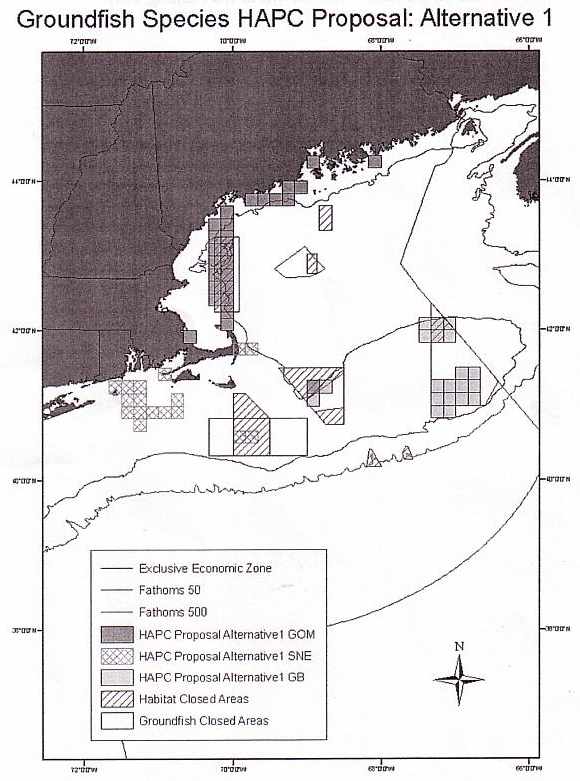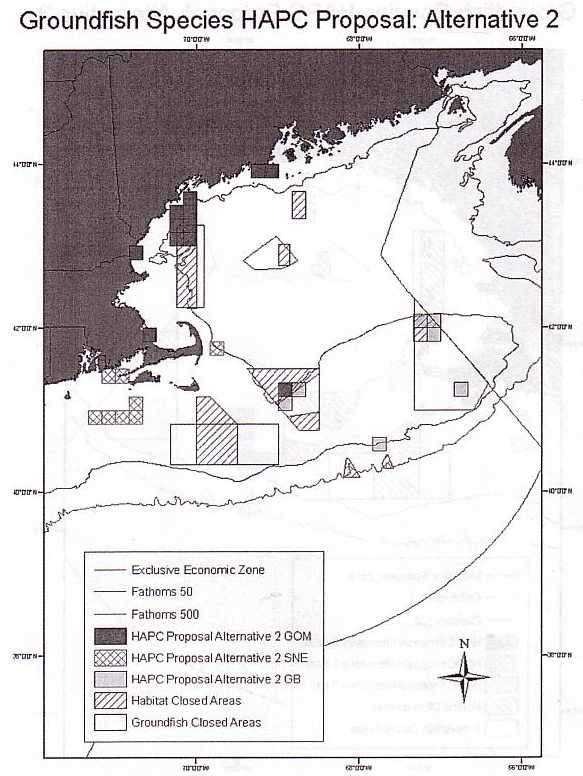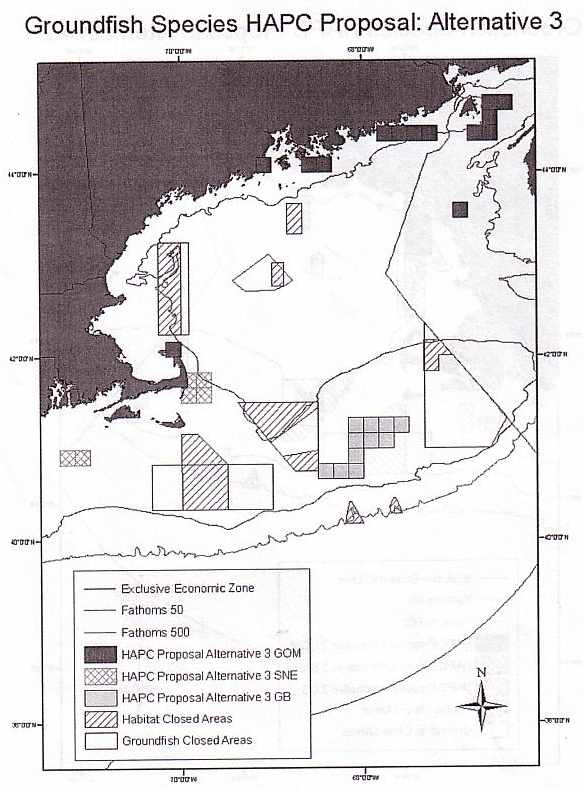Evaluation by NEFMC's HAPC Plan Development Team of the Gulf of Maine Groundfish Species Habitat Area of Particular Concern Proposal

Overview
The objective of this proposal (Figure 10 - Figure 12) is to identify habitat areas of particular
concern, for the juveniles of eight over-fished species managed by the NEFMC, using
abundance patterns as a guide. A minimal set of locations within each of three biogeographic
regions was identified that included habitat areas for each of the species. Juvenile fishes were
used because they are particularly vulnerable to benthic habitat impacts and because their
growth and maturation is essential to fisheries management objectives. Habitat areas were
identified based on abundance patterns revealed by 33 years of NMFS research surveys within
the Southern New England (SNE), Georges Bank (GB), and the Gulf of Maine (GOM) regions.
Candidate HAPC sites were identified using a site-selection computer program, making it
possible to efficiently meet abundance representation targets for each species. Targets were
defined based on relative abundance (fish/tow) using a ten-minute square (TMS) grid system.
The goal was to find the smallest set of TMS that met targets for the entire suite of species. This
proposal presents sets of candidate HAPCs, one set per region, which are designed to meet
multi-species habitat conservation objectives.
The method used for identifying the HAPCs was designed to identify sets of areas that simultaneously provide important habitat for all eight species. Habitat value was defined strictly on the basis of fish abundance and does not include any habitat attributes (depth, substrate, etc.), thus habitat value is presumed to be high in areas that support the greatest abundance of fish. This computer-based technique (MARXAN) searches through the multiple maps of relative abundance, seeking to find combinations of areas that are important for all the species while keeping the total area, boundary length, and the number of isolated sites to a minimum.
The proposal provides three HAPC alternatives, each of which was based on different optimization criteria. The first two favor the selection of ten minute squares inside the existing groundfish and habitat closed areas and not in Canadian waters. Alternative 1 was based on a less restrictive abundance target and produced 3-5 sites per region which made up 7-13% of the area of each region (9% overall). Alternative 2 was based on a more restrictive abundance target and produced 3-5 sites per region which made up about 3% of each region. Alternative 3 used the same abundance target as alternative 2, but assigned equal weight to TMS in U.S. and Canadian waters and to TMS inside and outside of closed areas.
Step 1: Does the proposed HAPC meet the criteria established under the EFH Final Rule?
1(A) - Importance of Historic Ecological Function:.
Not addressed.
1(B - Importance of Current Ecological Function:
Not addressed.
2 - Sensitivity to Anthropogenic Stresses:
Relative abundance is used as a proxy for (or indication of) habitat. The proposal addresses
anthropogenic stresses due to fishing but does not explicitly provide information on the
applicability of this effect on any of the candidate HAPC areas.
3 - Extent of Current or Future Development Stresses:
No current development stresses listed. A more qualified case is made for potential future
development, although the timing, scales, and locations are mostly unknown (e.g., after 2012 for
oil and gas due to a moratorium).

4 - Rarity of the Habitat Type:
The proposers maintain that the locations where the abundance of juvenile fishes is relatively
high are uncommon or rare by definition. The analysis presented here for the identification of
HAPC selects these places, and in this sense the HAPCs meet criterion 4. However, the PDT
feels that this reasoning is speculative.
Step 2: Does the supporting information justify the HAPC designation?
There is no supporting information to indicate the ecological importance, sensitivity to stress,
etc. of the proposed HAPC areas. What is known is that they meet target representation levels
for the abundance of the juvenile life stages of eight over-fished species of groundfish and
conform to other criteria (e.g., number of TMS, number of sites in a region) that have important
management implications. MARXAN or simulated-annealing requires substantial input
parameters, which the model must consider when selecting the optimum solution. While the
PDT felt that MARXAN may be a useful tool for HAPC designations, it was unsure that the
input parameters would meet with Council approval. It seems that the Council would need to
dictate these input parameters and/or weights (e.g. target representation, affinity for closed
areas or general size desired) before an acceptable range of solutions could be generated.
Step 3: How strongly does the information support the application?
The proposal gets high marks for its use of general resolution computer models, and the results
of field and laboratory studies are mentioned, but not specifically in reference to any of the
proposed HAPCs. The proposals are based on trawl survey estimates of abundance which are
used as a proxy for unspecified habitat characteristics to identify the location and size of
HAPCs. The spatial resolution of candidate HAPC areas is relatively low at the TMS scale (each
TMS equals about 75 square nautical miles). Data are from a long time series of annual fall and
spring trawl surveys (1970-2003); however, there is a potential problem if there have been
structural changes in the fish community (changes in species composition and/or abundance)
that were not controlled for in the analysis.
Further, there was a great deal of disagreement among PDT members in relation to the appropriateness of the use of survey distribution data to identify core habitats that should receive HAPC-designation level status. Some members thought that the use of these data, on which the EFH designations are based, was entirely supported in habitat-selection criteria literature. However, others believed that the use of areas of high catch rates as a proxy for habitat value fails to meet the intended purpose of an HAPC as defined in the EFH Final Rule, i.e., sub-sets of EFH that meet a higher standard of ecological importance.
Step 4: Evaluation of the HAPC based on the criteria and preferences set forth by the Council
The proposal does address two of the Council's preferences: inclusion of juvenile cod EFH and
EFH for more than one species. However, the strength/relevance of supporting information is
weak.
Instead, candidate HAPC areas identified in the three alternatives were defined using catch rate data from NEFSC trawl surveys and optimization criteria designed to create spatially efficient configurations of ten-minute squares. They were not based on ecological attributes or functionality in these areas, sensitivity to stress, habitat rarity, or threats of future development projects. Fish abundance was used as a proxy for habitat value in the existing EFH designations, but HAPC designations are meant to identify geographical sub-sets of EFH that have particular ecological value, e.g., hard bottom habitat that provides shelter and food for juvenile cod. The methodology used to define candidate HAPC areas (MARXAN) does not account for the spatial distribution of physical habitat features. Some PDT members concluded that this approach is really an attempt to define EFH on a multi-species basis, not a HAPC designation proposal. However, others disagreed and thought this was a useful approach but needed some fine-tuning on the input parameters. Some PDT members would like to see a solution based only on U.S. waters and not weighted to favor areas in current groundfish closed areas.
Also, the PDT noted that some of the proposed HAPC areas are not sub-sets of EFH (as
required by the EFH Final Rule). Alternative 3 includes ten-minute squares (TMS) in Canadian
waters. A penalty was assigned for TMS that were not EFH in alternatives 1 and 2, thus
steering the site selections away from non-EFH TMS but not eliminating them entirely. It is not
clear how this penalty was assigned or whether the solutions described in the proposal
included any TMS that were not designated as EFH. With 5-7 species in each region, it seems
unlikely that each TMS in each candidate HAPC area is EFH for each of the species that was
included in the analysis.

The supporting information provided in the proposal is not adequate because it relates primarily to the use of the computer program (Marxan) and studies that demonstrate the fact that fish densities are highest in areas of high habitat value. No site-specific information is provided relative to ecological attributes or vulnerability to fishing or non-fishing impacts. Two of the alternatives (#1 and #2) are entirely within the Council's purview. Unfortunately, no alternatives were provided which restrict choices to US waters AND do not bias choices in favor of the groundfish closed areas.
Step 5: A report of all proposal applications reviewed which would include: The grades and notes for each proposal that went through Step 1- Step 4, and a record/reason for any proposal received but not reviewed (incomplete, awaiting more information, etc.).
The PDT notes that the major strength of the proposal is that it does not start out with a pre- conceived solution, which is the strength of using an empirical model in general. However, this application of MARXAN may not be appropriate because it is not site-specific to EFH.
There was considerable disagreement among PDT members in relation to the appropriateness of the use of survey distribution data to identify core habitats that should receive HAPC- designation level status. Some members thought that the use of these data, on which the EFH designations are based, was entirely supported in habitat-selection criteria literature. However, others believed that the use of areas of high catch rates as a proxy for habitat value is unfounded. Additionally, these members pointed out that the NMFS bottom-trawl survey was not intended for this purpose and, as such, is not optimized as a study.
MARXAN or simulated-annealing requires substantial input parameters which the model must consider when selecting the optimum solution. While the PDT felt that MAIZXAN may be a useful tool for HAPC designations, it was unsure that the input parameters would meet with Council approval. It seems that the Council would need to dictate these input parameters and/or weights (e.g. target representation, affinity for closed areas or general size desired) before an acceptable range of solutions could be generated.
Other Comments
1. Normative issues - The technical aspects of the Groundfish HAPC Proposal are influenced a
great deal by several policy positions and value judgments. Although the Habitat PDT wants to
stay away from normative issues, it is important to at least flag the occurrences for the O/S
Committee. The applicants do a pretty good job of pointing out most of these themselves.
• MARXAN is an optimization technique. For example: "In setting targets we sought to strike a balance between needed benefits for fish populations and potential costs associated with limiting human impacts within HAPC areas" (p. 7) by holding the area used to a minimum.
• The species list is limited to "overfished" species (i.e., species judged overfished with respect to a food production objective) or species not overfished but of concern to the proposers.
• There is a strong bias in favor of choosing areas inside the year-round groundfish closed areas in Alternatives 1 and 2 presumably because it would be easier for the Councils to justify future habitat management actions in these areas.
• To their credit, the proposers reveal their desire for management measures that are designed "to maximize the ecological benefits of these habitat areas" (p. 27). There is a demand for ecological benefits among the public. And there are vehicles for protecting environmental quality (e.g., MPA executive order). However, EFH is intended to augment the production of targeted fish stocks, not preserve nature.
2. Technical issues -
• The conclusions about the economic benefits of the HAPCs - i.e., "these HAPCs ... will
also have significant economic benefits to the fishery" (p. 27) - detract greatly from this
proposal. The economics of fishery assets and fishing activities depend on the levels of
several types of capital, including physical capital as well as the natural resource (recall
the history of the sea scallop fishery, the Pacific halibut fishery, etc.). Rebuilt fish stocks
are essential - but hardly sufficient - conditions for positive net asset values and
benefits. Further, what might or might not happen because of Amendment 13 has
nothing to do with this HAPC proposal. These claims must be addressed.
• It may be technically correct to characterize Alternative 1 as being a "precautionary system of HAPCs" (p. 1). It does cover more total area than Alternative 2 due to a larger target for abundance, but the Alternative 2 abundance level was set at 10% as a matter of professional judgment, not as a technical solution.
• As mentioned above, there may be important structural changes in the biological communities during 1970-2003 that would affect the results, particularly the switch between gadids and elasmobranchs. However, this is not addressed in the proposal.
Likewise for the various changes in management regimes (NAFO to FCMA and Councils) and management policies (e.g., rotational closures in GOM beginning 1998).
• The contrast between Alternative 3 and Alternatives 1&2 is striking - no HAPCs are in the year-round groundfish closed areas in Alternative 3. This is a major result for the Council assuming it is appropriate to base areas on the abundance of juveniles.
Step 6: Outcome
The proposers should be commended for putting so much hard work into the proposal and responding to initial feedback by developing two new alternatives, however, many PDT members felt that the proposal doesn't meet the HAPC criteria established in the EFH Final Rule and should be rejected. With respect to Alternative 1 and 2 in the proposal, however, the PDT did note that if additional supporting information is provided on the habitat features of each individual solution block and the habitat features within each of these solution blocks meet the HAPC criteria, then the proposal could be reconsidered for recommendation to the Committee. Because proposal Alternative 3 includes solution blocks in Canadian waters, the PDT recommends that the alternative be rejected as the MARXAN model requires all blocks of a solution be implemented simultaneously for the solution to be technically valid.
The PDT noted that this is a useful demonstration of the MARXAN software capabilities and that the proposers have done a good job of showing how well the optimal solution for the first alternative meets the target representation level of abundance for each species. The proposal definitely needs some common basis for evaluation of each solution such as what percentile of EFH is included for each life stage.
END